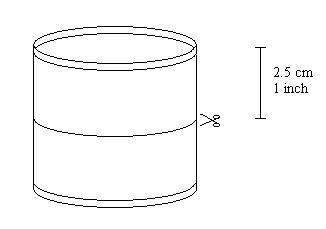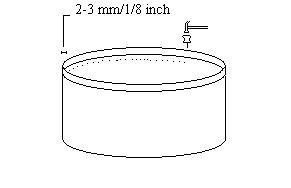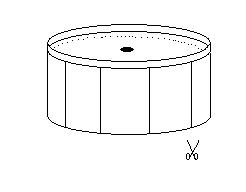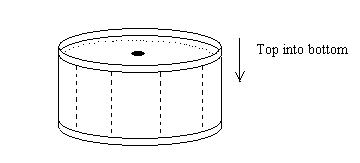What you need
Materials:
1 x Tunafish can (7 oz/200 gram)
2 x Tomato paste can (6 oz/180 gram)
1 x Short screw
Tape
Sheet of tin foil
Tools:
Thumb tack
Hammer
Scissors
Tin snip
Instructions
| 1. Use the tin-snip or the scissors to cut one tomato paste can so that it is approx. 1 inch (2.5cm) deep. Cut the other tomato paste can to the same depth. |
|
| 2. Use the thumb tack and the hammer to punch small holes (40-50) around the inside of the bottom of the can. About 1/8 inch (2-3 mm) from the edge. DO NOT PUNCH THE THUMB TACK NEEDLE COMPLETELY THROUGH. Make as small holes as possible. This will be the top of the burner. Use the hammer and the short screw to punch a hole that is just big enough for the screw to be screwed into the hole, in the middle of the can. This hole will be used to refuel the burner. |
|
| 3. Use the scissors or the tin snip to cut diagonal slits in the burner top. These slits makes it possible to force the top into the bottom of the burner. Use a hammer to force the top so far into the bottom that the burner is sealed. Tap gently at the edge of the top, with a hammer, to do this. |
|
| 4. Make a funnel out of the tin foil and tape that fits in the refueling hole of the burner. |
|
This is all you have to do to make a working stove, but you will probably want a windscreen and a stand for your pot too. I made this out of tin foil and a coat hanger, works OK. Just fold the tin foil 2-3 times so that it reaches the top of your pot when this is placed on the stand. It should be about 1 inch (2.5 cm) clearing between the top of the stove and the bottom of your pot. Make 5-8, 1/5 inch (0.5 cm) holes in the bottom of the tin foil. Make the tin foil circular and join the ends using binders. There should be about 0.5-1 inch (1-2 cm) clearing from the side of the pot to the windscreen all the way round.
How to light the stove
To make this stove burn it needs some preheating. To light the stove do the following.
1. Fill the stove with some fuel (alcohol) and seal the opening with the screw
2. Place the stove in the tuna fish can
3. Have approx 1 tea spoon of alcohol in the tuna fish can and light the alcohol.
4. While the burner preheats you can rig the windscreen and pot stand.
5. When the burner burns with a yellow flame about 4-6 inches high it is ready to cook.
Performance
This burner will with a windscreen made of tin foil have 1/2 liter (approx 17.5 oz) of water to a rolling boil in less than five minutes. And that was done outside with approx 5-10 m/s (breeze) wind. The water was cold directly from the tap (below room temperature). That is a very good performer.
I have not yet tested how much fuel it consumes but it is probably not very fuel efficient. With a simmer ring (my next project) it should be possible to adjust the heat output some.
The secret
I have been inspired by the following alcohol burning stoves while building my own:
Shane Graber stove is the most similar stove to mine. I was however disappointed by the cook time of this stove and have done three important changes to make my stove burn faster.
1. The top-part of the stove reaches all the way to the bottom of the stove. This is important for the alcohol to boil, thus generating pressure inside the stove. My earlier version of the stove died out with plenty of fuel to spare probably because the parts of the stove in contact with the alcohol wasn't hot enough for the alcohol to boil properly.
2. The stove is completely sealed. The Shane Graber stove probably have pressure leakage between the top of the stove and the the pop-can part. This possibly makes for slower burning.
3. More holes. Shane Graber makes a point that it is important to make as small holes as possible. I discovered that it was easy to make even smaller holes than he did using a hammer and a thumb-tack. He forced forced the thumb-tack all the way trough using his thumb.
I would appreciate any comments and feedback on the design of the stove. If you try it out please send me an e-mail to tell about your experience.
Thomas Tveit Rosenlund, 1999
ttr@idi.ntnu.no



